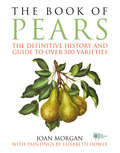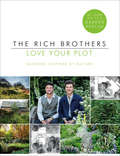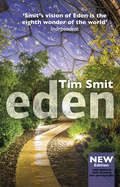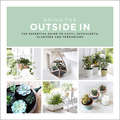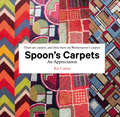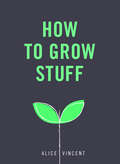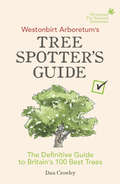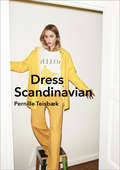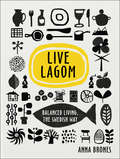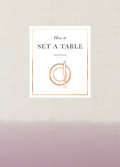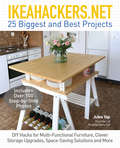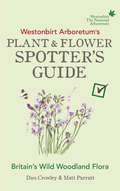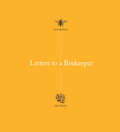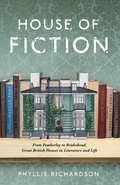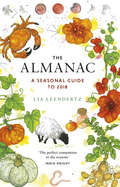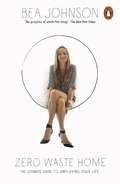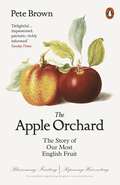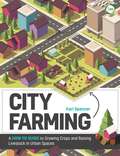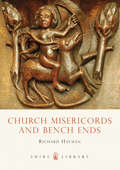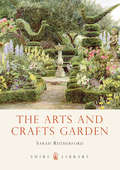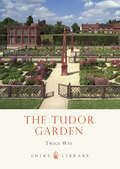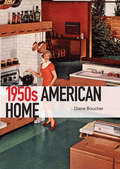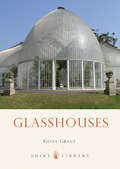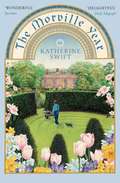- Table View
- List View
The Book of Pears: The Definitive History and Guide to over 500 varieties
by Joan MorganWinner of the Garden Media Guild Awards Reference Book of the Year 2016, the Guild of Food Writers Food Book of the year 2016, and the BBC Food & Farming Awards 2016 for Outstanding Achievement.Accompanied by a beautiful and comprehensive website of the same name, this wonderfully unique book is an indispensable and one-of-a-kind guide. It tells the story of the pear from its delightful taste and wonderful appearance to breeding and cultivation, following the fruit’s journey through history and around the world.Beautifully illustrated with 40 botanical watercolour paintings by Elisabeth Dowle, The Book of Pears is the most up-to-date and comprehensive guide to the pear. Moving through continents and cultures, Joan Morgan celebrates the pear’s long history as both a fresh and cooking fruit. Revealing the secrets of the pear as a status symbol, some of the most celebrated fruit growers in history, and how the pear came to be so important as an international commodity.The pear directory, which makes up the second half of the book, covers the world’s ancient and modern varieties, each with full tasting notes and historical, geographical and horticultural detail. A fully illustrated version of this directory is shown on the author's website www.thebookofpears.fruitforum.net
Love Your Plot: Gardens Inspired by Nature
by Harry Rich David RichFusing conceptual architectural design with the beauty of the natural landscape, twice Chelsea Flower Show Gold Medal winners and stars of BBC's Garden Rescue Harry and David Rich are here to show you how you can transform your outdoor space into a beautiful Eden, no matter what plot you have.As the youngest ever gold-medal winners for a main show garden at the Chelsea Flower Show and co-stars of BBC's Garden Rescue , Harry and David Rich blend their unique sense of conceptual design with the beauty of the natural landscape to create stunning garden designs that awe and inspire.In Love Your Plot Harry and David are setting out to help you transform your outdoor space into an inspiration green haven by making nature work for you. Fusing different outdoor elements, such as coastal and woodland landscapes, alongside key design principles, they will show you how to create a modern, practical and visually stunning outdoor space. Complete with practical tips, unique sketches and designs, planting suggestions and stunning full-colour visuals, Harry and David’s book will have you reaching for the spade and wellies in no time at all to create your own Eden, no matter what plot you’ve got.
Eden: Updated 15th Anniversary Edition
by Tim SmitUpdated, with stunning new photographs At the beginning of the twenty-first century, the impossible was delivered. From the sterile depths of a disused china clay pit in Cornwall rose one of the most remarkable and ambitious ventures in recent memory. The Eden Project’s Biomes, the world’s largest conservatories, are the symbol of a living theatre of plants and people and their interdependence, of regeneration and of a pioneering forum for the exploration of possible futures. This is the extraordinary story of the Eden Project, of its conception, design and construction, of the larger-than-life personalities who made it happen and of all that has happened since its doors were first opened to the public in 2001. It is now undisputedly one of the world’s great gardens with more than 17 million visitors flocking there and projects and partnerships all over the world.
Bring The Outside In: The Essential Guide to Cacti, Succulents, Planters and Terrariums
by Val BradleyTHE PERFECT GIFT FOR BEGINNERS"Everything you need to know about keeping plants in your house... lovely pictures, tips, tricks... I love it." (Zoe Sugg a.k.a Zoella)Love plants, but short on outdoor space? Or feeling inspired by striking terrariums and succulent gardens? Keen to create a unique home brimming with greenery? Then this is the book for you. With stunning photography and expert step-by-step tips, Bring The Outside In reveals everything you need to know to help your plants thrive, from dramatic statement foliage and miniature citrus trees to table-top terrariums and hanging planters. With chapters on orchids, cacti, herb gardens and chilli plants, your home will be flourishing in no time.
Spoon's Carpets: An Appreciation
by Kit CalessIf you’ve ever been in a Wetherspoon's (and who hasn't), you’ve probably looked down and noticed the brilliantly-hued carpet beneath your feet. But that carpet isn’t just for disguising spilt drinks… Each Wetherspoon has a carpet that is unique and bespoke, with a design inspired by the history of the building, its locale or the name of the pub. Thanks to the hit blog 'Wetherspoon's Carpets' – which posed the important question 'are any two Wetherspoon carpets the same?’ – these tapestried hymns to British boozers have become a cultural sensation. Now, Kit Caless has travelled the length and breadth of the UK, from Berkshire to Renfrewshire, Bradford to Bridgend, to photograph over 70 splendid carpets from Wetherspoons and meet some of the pubs' regulars. Each entry appears in all its glorious colour, along with Caless's witty and informative text on the inspiration for each carpet's design, the history of the pub and key facts about the branch and its regulars. Will your Spoons be there?
How to Grow Stuff: Easy, no-stress gardening for beginners
by Alice VincentThe essential guide to the simple art of growing stuff.Feeling green-fingered but not sure where to start? This book is for you. Growing stuff - herbs, veg, salad, flowers and plants - is fun and pretty easy. You just need some practical knowledge - all in this book - and a bit of space - a window ledge, pot or plot of soil. Then, have fun growing: basil, mint, parsley, rosemary, chillies, courgettes, rocket, tomatoes, geraniums, pansies, lavender, osteospurmum, daffodils, hyacinths, muscari, tulips, succulents, aloe vera, money plants, maidenhair ferns and oxalis.If you have no outside space at all, you can grow everything here inside too...
Westonbirt Arboretum’s Tree Spotter’s Guide: The Definitive Guide to Britain’s 100 Best Trees
by Dan CrowleyIn the depths of the Cotswolds, near Tetbury in Gloucestershire, lies one of the most beautiful tree gardens in the world, known as Westonbirt Arboretum. Here you can find around 15,000 trees, each one lovingly labelled. They offer the perfect, picturesque setting for escaping from the pressures of everyday life.Now, for the first time, 100 of the most popular British trees form the basis of this beautiful pocket guide. Illustrated with artwork depicting the tree and leaf, this covetable little book will educate and entertain with wonderfully concise text by one of the world’s leading tree experts from the Arboretum. Pop this book in your pocket for a great day out spotting some of the most celebrated features of our landscape!
Dress Scandinavian: Style Your Life And Wardrobe The Danish Way
by Pernille TeisbaekGet Scandi-cool with the Danish queen of minimal Scandinavia has long been the home of outstanding interior design and classic fashion brands like Acne Studios, Rains and Filippa K. But no one personifies modern Danish cool as well as fashion industry stylist, blogger and model Pernille Teisbaek.In her gorgeous first book Pernille offers professional tips on how to create a minimalist wardrobe and look, mix and match patterns successfully, adopt androgynous looks or new colour combinations, try out new materials and mix fabrics, plus plenty of timeless fashion advice such as a jeans-fit guide and essential Dos and Don’ts. Her beauty chapter reveals Pernille’s capsule survival kit and how to achieve her natural look.Pernille also covers pared-back Scandinavian home design with an eye on balancing elegant simplicity and minimalism with inviting homeliness and warmth, or hygge, and inspirational pictures.A perfect gift for all Scandi lovers and anyone wanting insider advice from one of fashion’s most stylish experts.
Live Lagom: Balanced Living, The Swedish Way
by Anna BronesYou’ve had hygge, now live lagom. Live Lagom is a guide to life based on the Swedish philosophy of lagom, meaning ‘not too little, not too much, just right’. Celebrated author of Fika and Nordic happiness expert Anna Brones explains the practice of Lagom in traditional and practical terms, and includes advice and tips on how to find your happy medium. Lagom helps you to achieve balance in everyday life and in all areas including home, work and health. Learn how to save money, feel less stressed, reduce your environmental impact, and create your ideal home and career through the way of life practised in one of the happiest and most satisfied countries in the world.Discover for yourself the trend that Elle described as ‘the more sustainable and enjoyable lifestyle we’ll all be wanting in 2017.’ Lagom allows you to enjoy the moment, and not only accept what you already have but also to make the most of it.
How to Set a Table: Inspiration, ideas and etiquette for hosting friends and family (How To Ser.)
by Clarkson PotterThis beautiful guide includes creative ways to style a table - for dinner, a cocktail party, brunch, picnic in the park, and other fun occasions.Whatever the size of your home or budget, How to Set a Table features stylish, modern ideas for welcoming friends and family in your home. This pretty gift book serves as a practical step-by-step guide to entertaining - with information on etiquette, place setting basics, centerpieces, mixing and matching, essential glassware, napkin folds, and unexpected ideas for using the great tableware you can find at flea markets. How to Set a Table updates a classic topic for a new generation of hosts.
IkeaHackers.Net: 25 Biggest and Best Projects: DIY Hacks for Multi-Functional Furniture, Clever Storage Upgrades, Space-Saving Solutions and More
by Jules YapTHINK OUTSIDE THE FLAT-PACK BOX: The ingenious team at IkeaHackers.net show you how to transform affordable IKEA products into creative new furniture and more...Step 1. Buy it at IKEA. Step 2. Open the box. Step 3. Throw away the instructions. Step 4. Have fun building your exciting new hack! By thinking outside the flat-pack box, author Jules Yap and the contributors to her wildly popular website IkeaHackers.net have come up with clever ways to repurpose IKEA's great products into even more useful and stylish furnishings for your home. Packed with ideas for every room, IKEA Hacks shows you how to mix-and-match, cut-and-paste, and saw-and-screw IKEA items in ways they never imagined. The inventive projects include a cat condo created using LACK tables, a children's playhouse constructed from KURA bed and TROFAST toy storage, and a Murphy bed made from PAX wardrobe, BALLSTAD doors and LUROY bed base. Each project comes complete with step-by-step instructions as well as full-colour illustrations and photos.
Westonbirt Arboretum’s Plant and Flower Spotter’s Guide
by Dan Crowley Matt ParrattGet back to nature with this easy to use guide to Britain's greenery. From the experts at Westonbirt Arboretum in the depths of the Cotswolds, with one of the most beautiful gardens in the world, comes this beautiful pocket guide covering 100 popular wild plants and flowers.Categorised by type of plant, the simple layout ensures that this text is easy to use ‘on the go’. Meadow Saffron, Sweet Woodruff and Solomon’s Seal are just a few examples of the vibrant entries - each accompanied by two beautiful images and a short description.Illustrated with enchanting colour artwork, depicting each plant and their individual bloom or sprig, this covetable book will educate and entertain with text by two leading experts from the Arboretum and the Forestry Commission.
Letters to a Beekeeper
by Alys Fowler Steve BenbowThis the story of how, over the course of a year, Alys, the Guardian gardening writer, learns how to keep bees; and Steve, the urban beekeeper, learns how to plant a pollinator-friendly garden.Part beautifully designed coffee-table book, part manifesto, this collection of engaging letters, emails, texts, recipes, notes and glorious photos creates a record of the trials, tribulations, rewards and joys of working with, rather than against, nature. And along the way, you will pick up a wealth of advice, tips and ideas for growing food and keeping pollinators well fed. Letters to a Beekeeper is for lazy gardeners, novice beekeepers and everyone in between. It is the best rule-breaking, wildlife-friendly, guerilla, urban gardening, insect-identifying, honey-tasting, wax-dripping, epistolary how-to book you could ever hope to own.
The House of Fiction: From Pemberley to Brideshead, Great British Houses in Literature and Life
by Phyllis RichardsonHouses in literature have captured readers’ imaginations for centuries, from Gothic castles to Georgian stately homes, Bloomsbury townhouses and high-rise penthouses. Step on to a tour of real and imagined houses that great English writers have used to reflect the themes of their novels… houses that became like characters themselves, embodiments of the social and historical currents of their time.Phyllis Richardson takes us on a journey through history to discover how authors’ personal experiences in their homes helped to shape the imaginative dwellings that have become icons of English literature:Virginia Woolf’s love of Talland House in Cornwall is palpable in To the Lighthouse, just as London’s Bloomsbury is ever-present in Mrs Dalloway. E.M. Forster’s childhood home at Rook’s Nest mirrors the idyllic charm of Howards End. Evelyn Waugh plotted Charles Ryder’s return to Brideshead while a guest at Madresfield. Jane Austen was no stranger to a manor house or a good ballroom. And Horace Walpole’s ‘little Gothic castle’ in Twickenham inspired him to write the first English Gothic novel, The Castle of Otranto.But the English country house, from the idyllic to the unloved, is also viewed through a modern lens – Kazuo Ishiguro’s Darlington Hall, Ian McEwan’s Tallis House, Alan Hollinghurts’s Two Acres.Using historic sources, authors’ biographies, letters, news accounts, and the novels themselves, The House of Fiction presents some of the most influential houses in Britain through the stories they inspired, while offering candid glimpses of the writers who brought them to life.
The Almanac: A Seasonal Guide to 2018
by Lia LeendertzThe Almanac revives the tradition of the rural almanac, connecting you with the months and seasons via moon-gazing, foraging, feast days, seasonal eating, meteor-spotting and gardening. Award-winning gardener and food writer Lia Leendertz shares the tools and inspiration you need to celebrate, mark and appreciate each moment of the year.
Zero Waste Home: The Ultimate Guide to Simplifying Your Life
by Bea JohnsonZero Waste Home is the ultimate guide to simplified, sustainable living from Bea Johnson, author of the popular blog zerowastehome.comLiving sustainably should not mean forfeiting either comfort or style. In this book Bea Johnson shows, by inspiring example, what green living looks like and offers a practical, step-by-step guide to diminishing our environmental footprints and improving our lives.It all comes down to the 5 Rs: Refuse, Reduce, Reuse, Recycle, Rot (and only in that order!). Zero Waste Home shows how these key principles can be applied to every area of your house from the kitchen to the kids' room, and it's packed with easy tips for all of us: from refusing freebies to using your plants as air fresheners.More than a manual, this is the inspiring story of how Bea Johnson transformed her family's health, finances, and relationships for the better by reducing their waste to an astonishing one litre per year.Could you do the same?
The Apple Orchard: The Story of Our Most English Fruit
by Pete BrownTaking us through the seasons in England's apple-growing heartlands, this magical book uncovers the stories and folklore of our most familiar fruit. 'An orchard is not a field. It's not a forest or a copse. It couldn't occur naturally; it's definitely cultivated. But an orchard doesn't override the natural order: it enhances it, dresses it up. It demonstrates that man and nature together can - just occasionally - create something more beautiful and (literally) more fruitful than either could alone. The vivid brightness of the laden trees, studded with jewels, stirs some deep race memory and makes the heart leap. Here is bounty, and excitement.'
City Farming: A How-to Guide To Growing Crops And Raising Livestock In Urban Spaces
by Kari SpencerFarming in cities and small spaces is becoming increasingly popular, but it has its challenges. City Farming addresses the problems the urban farmer might face and turns them into creative solutions. It assists the new grower to gain expert understanding of how to create a production urban farm, as well as helping established farmers to troubleshoot and discover new ways to bring their space into greater harmony and production. From the perspective of a holistic gardener, growing plants and raising livestock are covered as well as integrated approaches, which bring together the whole farming system in a small space to produce high yields with minimal energy and effort.The content is organised by themes of importance to urban farmers - sun and heat, water usage, seasonal production, spatial planning, soil quality and usage, propagation and breeding, pests and diseases, farming under time constraints, sustainability and community initiatives. These are all discussed within the context of urban farming and include common issues and strategies like microclimates in built-up areas, natural and organic approaches, water harvesting, toxic land, roof gardening, converting ornamental gardens to productive edible gardens, municipal regulations, vertical gardening, aquaponics, composting methods, livestock suitability in limited space, Community Supported Agriculture (CSA) schemes, permaculture in small spaces, community gardens and trade & barter schemes.Each chapter unfolds a piece the story of The Micro Farm Project that provides an overview of the theme, and then discusses the crop and livestock considerations relating to the theme of the chapter in the form of the challenges they present and practical solutions to the problems such as lack of space, high population density, poor soil quality, planning restrictions etc. Case studies giving examples of different methods used within urban farming from different regions throughout the world are included.City Farming is a beautifully illustrated source that can be valuable to both beginners and more experienced urban farmers.
City Farming: A How-to Guide To Growing Crops And Raising Livestock In Urban Spaces (PDF)
by Kari SpencerFarming in cities and small spaces is becoming increasingly popular, but it has its challenges. City Farming addresses the problems the urban farmer might face and turns them into creative solutions. It assists the new grower to gain expert understanding of how to create a production urban farm, as well as helping established farmers to troubleshoot and discover new ways to bring their space into greater harmony and production. From the perspective of a holistic gardener, growing plants and raising livestock are covered as well as integrated approaches, which bring together the whole farming system in a small space to produce high yields with minimal energy and effort.The content is organised by themes of importance to urban farmers - sun and heat, water usage, seasonal production, spatial planning, soil quality and usage, propagation and breeding, pests and diseases, farming under time constraints, sustainability and community initiatives. These are all discussed within the context of urban farming and include common issues and strategies like microclimates in built-up areas, natural and organic approaches, water harvesting, toxic land, roof gardening, converting ornamental gardens to productive edible gardens, municipal regulations, vertical gardening, aquaponics, composting methods, livestock suitability in limited space, Community Supported Agriculture (CSA) schemes, permaculture in small spaces, community gardens and trade & barter schemes.Each chapter unfolds a piece the story of The Micro Farm Project that provides an overview of the theme, and then discusses the crop and livestock considerations relating to the theme of the chapter in the form of the challenges they present and practical solutions to the problems such as lack of space, high population density, poor soil quality, planning restrictions etc. Case studies giving examples of different methods used within urban farming from different regions throughout the world are included.City Farming is a beautifully illustrated source that can be valuable to both beginners and more experienced urban farmers.
Church Misericords and Bench Ends (Shire Library #230)
by Richard HaymanWith the increasing disappearance of stained glass in medieval churches, the surviving wood carvings on church misericords and bench ends are extremely important in providing an insight into the medieval mind. The carved images were often used to convey the messages of the Christian faith in the Middle Ages but they were not just concerned with religion and religious symbols – they also told stories of mythology, humour and satire, showing illustrations of everyday life and people. This book outlines the history of church seating and discusses the craftsmen and the influences behind their work. Using illustrations, the author then explains the subject matter of these wood carvings, revealing how one can discover so much about medieval life – the spiritualism, moralism and the wit – within the carvings still found in churches today.
The Arts and Crafts Garden (Shire Library #771)
by Sarah RutherfordThe Arts and Crafts Movement espoused values of simplicity, craftsmanship and beauty quite counter to Victorian and Edwardian industrialism. Though most famous for its architecture, furniture and ornamental work, between the 1890s and the 1930s the movement also produced gardens all over Britain whose designs, redolent of a lost golden era, had worldwide influence. These designs, by luminaries such as Gertrude Jekyll and Sir Edwin Lutyens, were engaging and romantic combinations of manor-house garden formalism and the naive charms of the cottage garden – but from formally clipped topiary to rugged wild borders, nothing was left to chance. Sarah Rutherford here explores the winding paths and meticulously shaped hedges, the gazebos and gateways, the formal terraces and the billowing border plantings that characterised the Arts and Crafts garden, and directs readers and gardeners to where they can visit and be inspired by these beautiful works of art.
The Tudor Garden: 1485–1603 (Shire Library)
by Twigs WayContrived, colourful and cultured, the Tudor garden was a paradise on earth, given over to pleasurable pastimes and aesthetic effect. Artificiality was the fashion of the age, with clipped and twining plants vying for space with brightly painted woodwork and patterned beds.Renaissance discoveries reared their heads in royal gardens, where gilded and painted heraldic figures mingled with fantastical sundials and glittering fountains. Walls kept out the wild world beyond, while mounts afforded glimpses to new parklands and provided raised platforms for the banqueting houses of the wealthy. Ever-changing with newly introduced exotic plants, yet featuring year-round knot gardens, the Tudor garden was a vibrant pageant, and is given a suitably colourful celebration in this fully illustrated book.
The 1950s American Home (Shire Library USA #740)
by Diane BoucherModern living began with the homes of the 1950s. Casting aside the privations of the Second World War, American architects embraced the must-have mod-cons: they wrapped fitted kitchens around fridges, washing machines, dishwashers and electric ovens, gave televisions pride of place in the living room, and built integrated garages for enormous space-age cars. So why was this change so radical? In what ways did life change for people moving into these swanky new homes, and why has the legacy of the 1950s home endured for so long? Diane Boucher answers these questions and more in this colorful introduction to the homes that embody the golden age of modern design.
Glasshouses (Shire Library #747)
by Fiona GrantSince the early seventeenth century, when the cultivation of exotic plants and fruit became fashionable in northern Europe, glasshouses have offered an artificial climate in which they could flourish. At first these structures were within reach only of the very richest, and growing one's own oranges, orchids, pineapples or bananas was a sign of great wealth; but by the mid-nineteenth century manufacturers emerged to cater for a growing middle-class market. Glasshouses became increasingly sophisticated, with different types tailored to house specific crops, and manufacturers competing with one another by developing their own house styles, leading to a wealth of designs endlessly fascinating to the garden or architectural historian. In Glasshouses, Fiona Grant provides an illustrated introduction to the subject, including the twentieth century decline and recent attempts at restoration.
The Morville Year
by Katherine SwiftOne of the most admired gardening writers of her generation, Katherine Swift returns to describe a year in the life of her garden she created over twenty years in the grounds of the Dower House at Morville, Shropshire, meditating on everything from the terrain and its history, to the plants and trees, and the odd habits of the animals and humans who inhabit the garden.Following the turning wheel of the Morville seasons, from the green shoots of spring, through summer and autumn, to the stark beauty of winter, and back to spring again, The Morville Year is a journal full of surprises and enchantments that will appeal not only to gardeners, but to all who enjoy the natural world.
